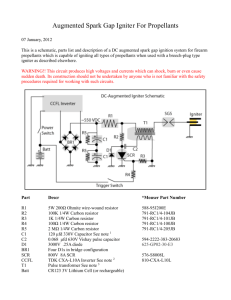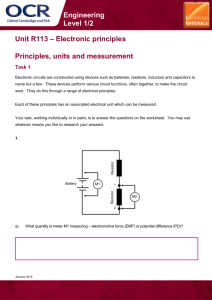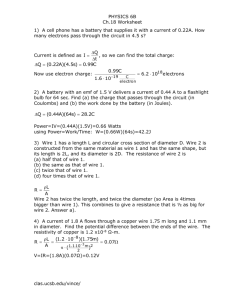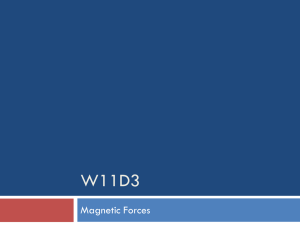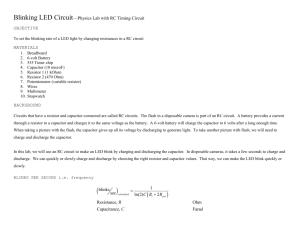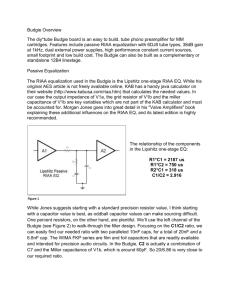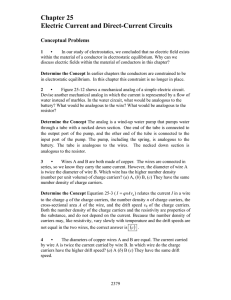general physics 2
advertisement
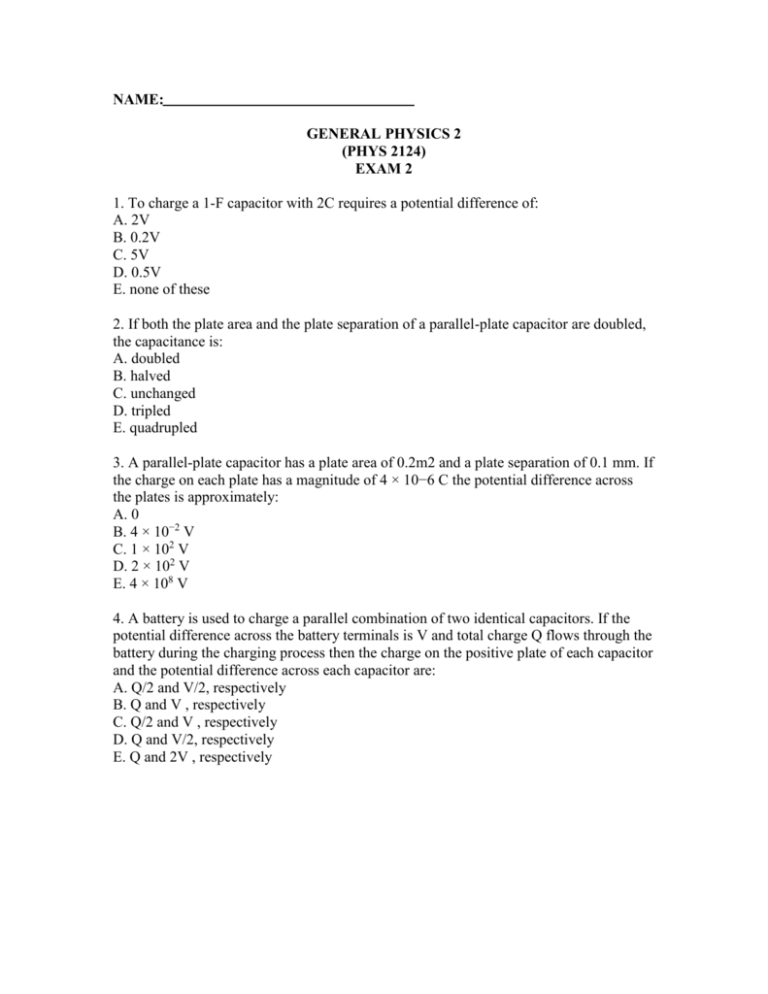
NAME: GENERAL PHYSICS 2 (PHYS 2124) EXAM 2 1. To charge a 1-F capacitor with 2C requires a potential difference of: A. 2V B. 0.2V C. 5V D. 0.5V E. none of these 2. If both the plate area and the plate separation of a parallel-plate capacitor are doubled, the capacitance is: A. doubled B. halved C. unchanged D. tripled E. quadrupled 3. A parallel-plate capacitor has a plate area of 0.2m2 and a plate separation of 0.1 mm. If the charge on each plate has a magnitude of 4 × 10−6 C the potential difference across the plates is approximately: A. 0 B. 4 × 10−2 V C. 1 × 102 V D. 2 × 102 V E. 4 × 108 V 4. A battery is used to charge a parallel combination of two identical capacitors. If the potential difference across the battery terminals is V and total charge Q flows through the battery during the charging process then the charge on the positive plate of each capacitor and the potential difference across each capacitor are: A. Q/2 and V/2, respectively B. Q and V , respectively C. Q/2 and V , respectively D. Q and V/2, respectively E. Q and 2V , respectively 5. Current has units: A. kilowatt·hour B. coulomb/second C. coulomb D. volt E. ohm 6. A 10-ohm resistor has a constant current. If 1200C of charge flow through it in 4 minutes what is the value of the current? A. 3.0A B. 5.0A C. 11A D. 15A E. 20A 7. Five cylindrical wires are made of the same material. Their lengths and radii are wire 1: length L, radius r wire 2: length L/4, radius r/2 wire 3: length L/2, radius r/2 wire 4: length L, radius r/2 wire 5: length 5L, radius 2r Rank the wires according to their resistances, least to greatest. A. 1, 2, 3, 4, 5 B. 5, 4, 3, 2, 1 C. 1 and 2 tie, then 5, 3, 4 D. 1, 3, 4, 2, 5 E. 1, 2, 4, 3, 5 8. Which of the following graphs best represents the current-voltage relationship for a device that obeys Ohm’s law? 9. An certain resistor dissipates 0.5W when connected to a 3V potential difference. When connected to a 1V potential difference, this resistor will dissipate: A. 0.5W B. 0.167W C. 1.5W D. 0.056W E. none of these 10. In the circuit below, what is the current I? A. 4.272 A B. 3.182 A C. -3.182 A D. -4.272 A E. none of these 10 5 I 4 50 V 10 V 0.545A 3.727A 11. A battery is connected across a parallel combination of two identical resistors. If the potential difference across the terminals is V and the current in the battery is i, then: A. the potential difference across each resistor is V and the current in each resistor is i B. the potential difference across each resistor is V/2 and the current in each resistor is i/2 C. the potential difference across each resistor is V and the current in each resistor is i/2 D. the potential difference across each resistor is V/2 and the current in each resistor is i E. none of the above are true 12. By using only two resistors, R1 and R2, a student is able to obtain resistances of 3 Ω, 4Ω, 12Ω, and 16 Ω. The values of R1 and R2 (in ohms) are: A. 3, 4 B. 2, 12 C. 3, 16 D. 4, 12 E. 4, 16 13. Nine identical wires, each of diameter d and length L, are connected in series. The combination has the same resistance as a single similar wire of length L but whose diameter is: A. 3d B. 9d C. d/3 D. d/9 E. d/81 14. Four circuits have the form shown in the diagram. The capacitor is initially uncharged and the switch S is open. The values of the emf E, resistance R, and capacitance C for each of the circuits are circuit 1: E = 18V, R = 3Ω, C = 1µF circuit 2: E = 18V, R = 6Ω, C = 9µF circuit 3: E = 12V, R = 1Ω, C = 7µF circuit 4: E = 10V, R = 5Ω, C = 7µF Rank the circuits according to the current just after switch S is closed least to greatest. A. 1, 2, 3, 4 B. 4, 3, 2, 1 C. 4, 2, 3, 1 D. 4, 2, 1, 3 E. 3, 1, 2, 4 15. A charged capacitor is being discharged through a resistor. At the end of one time constant the charge has been reduced by (1 − 1/e) = 63% of its initial value. At the end of two time constants the charge has been reduced by what percent of its initial value? A. 82% B. 86% C. 100% D. Between 90% and 100% E. Need to know more data to answer the question SHOW ALL WORK: In the circuit shown, what is the loop equation for the upper loop? 10 V 8 I1 4 14 V I2 4 I3 3 6 3 28 V

